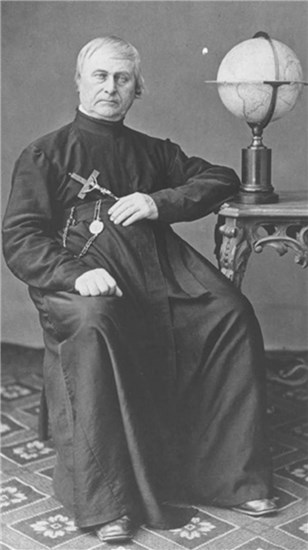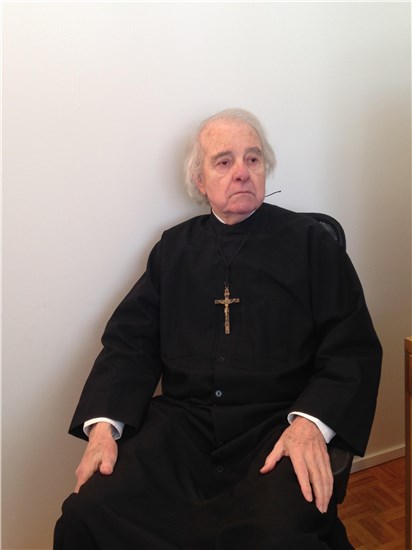

Father De Smet (1801-1873)
by George Frein
People went West for many things: furs, gold, land. Father De Smet went for the sake of souls who sought him out. Indians from the Rocky Mountains found him serving a mission church in Council Bluff, Iowa, in 1839 and asked him to come west and talk with them about the Great Spirit.
De Smet was glad to go. Council Bluffs, he had already decided, was entirely too close to white civilization for a successful mission. Indians there were corrupted by what he called the “dregs of civilization” -- gamblers and whisky salesmen.
In 1840 De Smet traveled to the remote territory of the Flatheads to see if a mission among them would be worthwhile. It took only a summer for the priest to decide the native people were indeed open to the gospel, and the next year he led a party of five Jesuits to the Bitterroot Mountains near present day Missoula, Montana. There they built St. Mary’s Mission.
While the other Jesuits settled into the work of resident clergy, De Smet moved further west to Fort Vancouver on the Pacific coast. Everywhere he went in the West De Smet found people he judged ready for the gospel. But De Smet himself would never become a mission resident. No sooner did he found a mission than he went back East to raise funds and find clergy to staff it. In 1843 he went recruiting in Europe and returned to the Pacific coast missions by way of Cape Horn with sisters of Notre Dame de Namur.
As soon as he got the nuns settled, De Smet set out to visit Jesuit colleagues and old converts at the first missions. By now what lured him to the West was the landscape as well as souls. De Smet loved to travel. He wrote of his visit to the Kootenai: “This is the ne plus ultra of wilderness. The forest is so dense that one seemed condemned never to emerge. . . . [Then in the mountains] one must travel . . . scaling by the aid of pickaxe, deep declivities and awe-inspiring heights.”
De Smet loved the out-of-doors, perhaps too much. When his religious superior read a report of the priest’s travels, he said, “De Smet is not a missionary; he’s a vagabond.” And he transferred “the vagabond” to a desk job at St. Louis University. It nearly killed him.
What eventually saved De Smet from his soul-destroying desk was the need the government had to settle hostilities in the West. Peace became a new mission for the old missionary. Five times De Smet acted as peace envoy for the U. S. government. The first time was at Fort Laramie, Wyoming Territory in 1851. There 10,000 Indians gathered and agreed to allow a road to be built through their land in exchange for fixed annuities. Next, De Smet went to Oregon with General Harney, who said the priest would bring more peace than the army ever could. His last three missions were in Dakota Territory, in the 1860s. These missions all failed because the government refused to fulfill the treaties it signed.
Of those who went to the West, none saw more of it than Father De Smet; none wished the native peoples more goodwill; none loved to travel more than he; and none sought peace more earnestly than De Smet.
Recommended Reading
Carriker, Robert, Father Peter John De Smet: Jesuit in the West. University of Oklahoma Press, 1995.
De Smet, Pierre Jean S. J., Letters and Sketches: With a Narrative of a Year’s Residence Among the Indian Tribes of the Rocky Mountains. Nabu Press, 2010.
Killoren, John J., Come Blackrobe: De Smet and the Indian Tragedy. University of Oklahoma Press, 1994.
Peterson, Jacqueline and Laura Peers, Sacred Encounters: Father De Smet and the Indians of the Rocky Mountain West. University of Oklahoma Press, 1993.
George Frein
George Frein is a retired college professor. He is so fully retired that this past winter he did all his traveling seated by the fireplace in a Collegeville, Minnesota apartment with a book in his lap and more books on the table next to his chair. His fireside traveling included many journeys through the Rocky Mountains in the company of Father De Smet. In previous winters George has traveled −fireside − to the South Seas with Herman Melville; to the collective unconscious with Carl Jung; to Washington, D. C. with Abraham Lincoln; to bird sanctuaries from Nova Scotia to Florida with John James Audubon; to cathedrals in France with Henry Adams; to Massachusetts with John Adams and John Winthrop; to Who-ville and Solla Sollew with Dr.Seuss; to almost everywhere with Mark Twain. Finally, as a break from all this literary traveling, George went to the movies where he traveled to Xanadu with Orson Welles.
Bullet Points
-
The Jesuit missionary, Father Peter John De Smet, “Blackrobe” to the Indians he befriended, has been called the “Apostle to the Rocky Mountains.”
-
Father De Smet traveled 180,000 miles establishing, visiting, and promoting missions in the Rocky Mountain West. He traveled by covered wagon, by horseback, by river boat, on foot, and even on snow shoes.
-
In addition to his missionary work, Father De Smet served as a peace envoy for the U. S. Government. The priest was one of the best-known and most-respected white men in the Rocky Mountain West.
Quotes
-
“I always miss something when I am not among my good Indians. I am conscious of a certain void wherever I go, until I come again to my dear Rocky Mountains. Then calm comes back to me; then only am I happy.”
-
“They [Indians of the Rocky Mountains] are well-mannered, gay, and very hospitable; their tent is open house; key and locks are unknown. Often I said to myself, ‘There are the people that civilized men dare to call barbarians!’
-
“I had traveled the Willamette, crossed the Rocky Mountains, passed through the country of the Blackfeet, the desert of the Yellowstone, and descended the Missouri; and in all these journeys I had not received the slightest injury.”
-
[Riding on the trail to Fort Laramie, De Smet thought] “The mind becomes clearer, the faculties are more alive, and ideas spring forth more spontaneously.”
-
“The Oregon Trail is the broadest, longest and most beautiful road in the whole world.”
-
“Since the discovery of America the system of removing and exiling the Indians farther inland, has been assiduously exercised by the whites. . . . The drama of spoliation has reached its last act, both east and west of the Rocky Mountains.”
-
“It is my view that if the inhabitants of the Indian Territory were treated with more justice they would cause little trouble.”
-
“In my view the future prospect of the Indian tribes is very dark and melancholy.”
Timeline
1821 De Smet comes to America to join the Jesuits and become a missionary to Native Americans.
1827 His studies completed, De Smet is ordained a priest.
1833 De Smet becomes an American citizen.
1838 After recovering from a serious illness, De Smet is assigned to a mission to the Potawatomi at Council Bluffs, Iowa.
1840 De Smet travels across the plains to see if a mission could be established among the Flatheads in the Rocky Mountains.
1841 - 42 He establishes St. Mary’s Mission in the Bitterroot Mountains, then travels down the Columbia to Fort Vancouver before returning overland to St. Louis.
1843 - 44 De Smet writes a book about his travels among the Indians of the Rocky Mountains, goes on a begging tour in the states and then in Europe. He sees the Pope, recruits priests and nuns for the missions, returning to America by way of Cape Horn.
1845 - 46 He visits old missions and scouts out locations for new ones; he especially enjoys winter travel in the Canadian Rockies.
1847 - 51 Father De Smet is relieved of his Rocky Mountain mission assignment by his Jesuit superior and given a desk job at St. Louis University. He attends the peace conference at Laramie.
1852 - 59 De Smet escapes from his desk job to become an army chaplain with General Harney. He sees the pressure put on native people by white settlers in the mountains.
1860 - 65 While the nation fights a civil war, De Smet defends the Indians as best he can from the Indian wars that are beginning.
1866 - 68 De Smet works as a government envoy during the Sioux War. He brings Indians to peace councils but cannot get the government to keep the treaties it signs.
1869 - 73 In ill health, De Smet still wants a mission among the Sioux. He attends a meeting in Washington, called by President Grant, to plan for missions to the Indians.